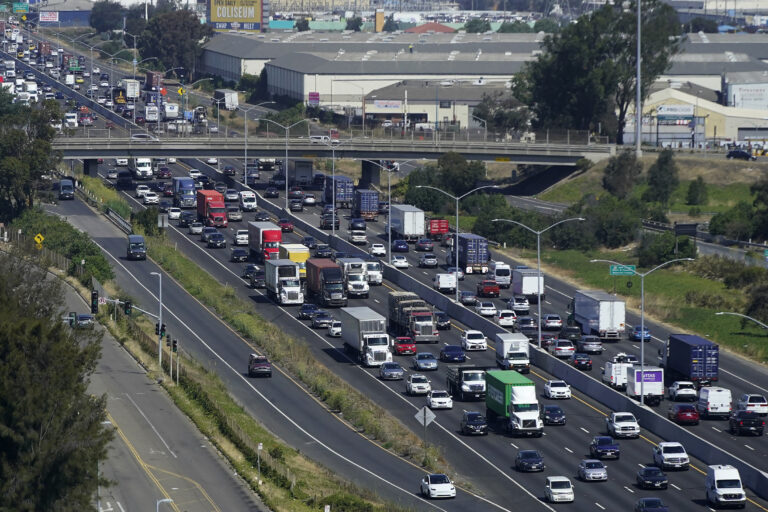Better for the Environment?
"[Cars] that used to weigh a ton and a half are now three tons [in weight].""It's not good for the environment, it's not good for resources, it's not good for efficiency."Ned Curic, chief technology officer, Stellantis NV
 | ||
| California Freeway Traffic CCC |
In 1980 the average vehicle sold in North America was lighter by a thousand pounds than currently-produced vehicles. Now, the average weight of a new vehicle comes to 4,329 pounds. Over a third of the weight of the average car produced in the United States has crept in in the past 40 years. And with the growing trend to switch to electric models that move is exacerbated. Years ago, when fossil fuels became expensive it was because OPEC imposed an
embargo against the United States in retaliation for the U.S. decision
to re-supply the Israeli military and to gain leverage in the post-war
peace negotiations.
That event saw a switch to the manufacture of smaller vehicles and to more fuel-efficient vehicles coming to market. Then the price of energy gradually 'normalized' and people began a love affair with larger vehicles like SUVs, to the point where trucks and SUVs vastly outnumber plain old sedans and other passenger vehicles of more modest build. Guess what; OPEC (Organization of Petroleum Exporting Countries] is at it again.
And to complicate things even further, environmentalists have warned the world that new weather trends producing more the more violent of nature's weather events are a result of man-made stresses on the environment, and the need to cut back on the production of carbon dioxide in the atmosphere is crucial to returning the world to its pre-climate-change status to stop an accelerating rate of such violent weather events.
Reining in vehicle weight at Stellantis, which produces the Jeep, Dodge and Chrysler brands among others, Curic states, is his most pressing engineering challenge. The 1980s saw the beginning of the current wave of vehicle bloat, partially due to new safety regulations. Airbags, for example, crash-test ratings and increasingly robust structures began to make vehicles more weighty. Improved construction, and stronger materials reduced the need for engineers to be concerned about weight as priorities turned away from efficiency.
The customer, we now know, isn't always right, but auto manufacturers in particularly are eager to please their customer base to remain in operation and so, in 2018 demand for large SUVs and pickups cancelled sedans and hatchbacks in North America. True, some trucks lost weight in the past ten years, but the overall fleet average continues climbing with the trend to more suburban families trading their Toyota and Honda sedans for Ford F-150s and Chevy Silverados.
When strides toward better fuel economy and emissions reductions emerged, a process that put on more pounds and culminated in some of the heaviest vehicles yet, the die was cast. Buyers got what they wanted; weighty battery-powered vehicles where EV batteries add about 1,000 to 1,500 pounds for a long-range sedan or SUV. Figures that could easily double when the larger new pickup trucks arrive within the next dozen months; the 8,000-pound Chevy Silverado and the steel-plated Tesla Cybertruck.
Stellantis produces one of the hulks; the 6,000-lb Ram, while initiating its transition to EVs as the heaviest automaker in the United States whose vehicles emit the highest CO2-emissions and deliver the lowest fuel economy, according to the Enviromental Protection Agency's preliminary 2022 data. There is no improvement on the products produced by Ford Motor Co. and General Motors on fleetwide metrics.
 |
The goal to trade out polluting cars and trucks for cleaner EVs has its perceived long-term advantages for the environment. Roadways packed with four-ton metal hunks however, are less safe. When 1,000 extra pounds are added to a vehicle, the chance of fatalities in a crash increases by a whopping 47 percent, according to a study produced by the National Bureau of Economic Research.
While some countries in Europe have taken to addressing this very problem by taxing vehicles based on their weight, in the U.S. crash fatality rates rose to a 20-year high and are now worse than in similar higher-income countries, and vehicle weight remains a key factor. Transitioning to EVs is kicking into high gear, giving automakers more reason to focus on cutting down on the weight of their heavier vehicles.
But as they continue to require larger, more expensive batteries, high weight and low efficiency becomes a costly combination where carmakers, unable to maintain weight under control, will see themselves uncompetitive on price or range.
 |
| In a car crash, what would you rather be in – the Smart, or the Mercedes S-Class? Driving |
Labels: Battery Weight, Deadly Accidents, Environmental Concerns, EV Vehicles
0 Comments:
Post a Comment
<< Home